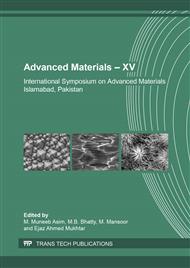[1]
D. Thompson, B. Subramanya, S. Levy, Quench rate effects in Al-Zn-Mg-Cu alloys, Metallurg. Mater. Trans. B, 2 (1971) 1149-1160.
DOI: 10.1007/bf02664247
Google Scholar
[2]
D. Tanner, J. Robinson, Residual stress magnitudes and related properties in quenched aluminium alloys, Mater. Sci. Technol., 22 (2006) 77-85.
DOI: 10.1179/174328406x79414
Google Scholar
[3]
B. Shang, Z. Yin, G. Wang, B. Liu, Z. Huang, Investigation of quench sensitivity and transformation kinetics during isothermal treatment in 6082 aluminum alloy, Mater. Des., 32 (2011) 3818-3822.
DOI: 10.1016/j.matdes.2011.03.016
Google Scholar
[4]
E. Brinksmeier, J. Cammett, W. König, P. Leskovar, J. Peters, H. Tönshoff, Residual stresses-measurement and causes in machining processes, CIRP Annals-Manufact. Technol., 31 (1982) 491-510.
DOI: 10.1016/s0007-8506(07)60172-3
Google Scholar
[5]
J. Robinson, D. Tanner, C. Truman, A. Paradowska, R. Wimpory, The influence of quench sensitivity on residual stresses in the aluminium alloys 7010 and 7075, Mater. Character., 65 (2012) 73-85.
DOI: 10.1016/j.matchar.2012.01.005
Google Scholar
[6]
J. Robinson, S. Hossain, C. Truman, A. Paradowska, D.J. Hughes, R. Wimpory, M. Fox, Residual stress in 7449 aluminium alloy forgings, Mater. Sci. Eng.: A, 527 (2010) 2603-2612.
DOI: 10.1016/j.msea.2009.12.022
Google Scholar
[7]
G. Dolan, J. Robinson, Residual stress reduction in 7175-T73, 6061-T6 and 2017A-T4 aluminium alloys using quench factor analysis, J. Mater. Proces. Technol., 153 (2004) 346-351.
DOI: 10.1016/j.jmatprotec.2004.04.065
Google Scholar
[8]
S. Liu, Q. Zhong, Y. Zhang, W. Liu, X. Zhang, Y. Deng, Investigation of quench sensitivity of high strength Al–Zn–Mg–Cu alloys by time-temperature-properties diagrams, Mater. Des., 31 (2010) 3116-3120.
DOI: 10.1016/j.matdes.2009.12.038
Google Scholar
[9]
J.S. Robinson, D.A. Tanner, C. Truman, R. Wimpory, Measurement and prediction of machining induced redistribution of residual stress in the aluminium alloy 7449, Experi. Mech., 51 (2011) 981-993.
DOI: 10.1007/s11340-010-9389-4
Google Scholar
[10]
B. Denkena, D. Boehnke, L. De Leon, Machining induced residual stress in structural aluminum parts, Prod. Eng., 2 (2008) 247-253.
DOI: 10.1007/s11740-008-0097-1
Google Scholar
[11]
M.B. Prime, M.R. Hill, Residual stress, stress relief, and inhomogeneity in aluminum plate, Scr. Materi.a, 46 (2002) 77-82.
DOI: 10.1016/s1359-6462(01)01201-5
Google Scholar
[12]
D.A. Tanner, J.S. Robinson, R.L. Cudd, Cold compression residual stress reduction in aluminium alloy 7010, in: Materials science forum, Trans. Tech. Publ., 2000, pp.235-240.
DOI: 10.4028/www.scientific.net/msf.347-349.235
Google Scholar
[13]
D.A. Lados, D. Apelian, L. Wang, Minimization of residual stress in heat-treated Al–Si–Mg cast alloys using uphill quenching: Mechanisms and effects on static and dynamic properties, Mater. Sci. Eng.: A, 527 (2010) 3159-3165.
DOI: 10.1016/j.msea.2010.01.064
Google Scholar
[14]
D. Tanner, J. Robinson, Reducing residual stress in 2014 aluminium alloy die forgings, Mater. Des., 29 (2008) 1489-1496.
DOI: 10.1016/j.matdes.2007.07.002
Google Scholar
[15]
M. Koc, J. Culp, T. Altan, Prediction of residual stresses in quenched aluminum blocks and their reduction through cold working processes, J. Mater. Proc. Technol., 174 (2006) 342-354.
DOI: 10.1016/j.jmatprotec.2006.02.007
Google Scholar
[16]
D. Tanner, J. Robinson, Modelling stress reduction techniques of cold compression and stretching in wrought aluminium alloy products, Fini. Elem. Anal. Des., 39 (2003) 369-386.
DOI: 10.1016/s0168-874x(02)00079-3
Google Scholar
[17]
J. Robinson, D. Tanner, Residual stress development and relief in high strength aluminium alloys using standard and retrogression thermal treatments, Mater. Sci. Technol., 19 (2003) 512-518.
DOI: 10.1179/026708303225001939
Google Scholar
[18]
J. Robinson, D. Tanner, Reducing residual stress in 7050 aluminum alloy die forgings by heat treatment, J.Eng. Mater. Technol., 130 (2008) 031003.
DOI: 10.1115/1.2931150
Google Scholar
[19]
N. Rossini, M. Dassisti, K. Benyounis, A.G. Olabi, Methods of measuring residual stresses in components, Mater. Des., 35 (2012) 572-588.
DOI: 10.1016/j.matdes.2011.08.022
Google Scholar


